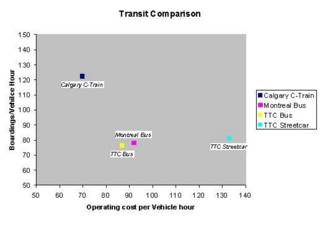Part I of this series reveals that TTC streetcars are not achieving their promised capacity advantage - and that the inexpensive, lowly bus is providing equal or even better performance.
In this installment, I begin to examine why the larger, more expensive-to- operate, and more capital intensive streetcar is not living up to its billing - (surely the Doug Wickenheiser of the transit world).
Some remarks on capacity
One needs to take care when using the term "capacity" in relation to elements of a public transportation system. There are many terms of capacity:
For the vehicles themselves:
Seating capacity
Planning capacity
Natural Capacity
Crush load capacity
For a given route:
Capacity over a whole route for a day
Peak capacity of a route in one direction
Rush hour capacity over the rush hour period
Those in the transit ‘business’ tend to use capacity arguments to bolster cases for their preferred technology. There is a long history of internecine strife between rail advocates and bus advocates - who use wildly differing assumptions on factors such as vehicle capacity and minimum headway (time between vehicles) to promote their favourites and dismiss the alternatives. These arguments are usually theoretical. Here we avoid the crossfire in this pseudo-religious war by using:
1. Real data - i.e. these are actual numbers from operating transit services
2. The boardings/service hour measure (rather than the intermediate measures listed above)
3. Some personal observations and measurements
So let us examine where the capacity vanishes:
1. Spare factors
A vehicle can even be available for one of those service hours when it is not undergoing maintenance. TTC streetcars require over 2.5 times the vehicle maintenance as do its buses. This means more time in the shop - and less time picking up, moving and dropping off passengers. Per the 2003 IBI Report ("Review of TTC Key Performance Measures - Feb 18th 2003), the spare ratios are (2001 figures):
Streetcar: 29.2 % VS Bus: 13.8 %
While the streetcar figure may reflect some inherent unused slack (i.e. truly spare), an analysis of the TTC routes by streetcar advocate Steve Munro ("Transit’s Lost Decade" - undated ca. 2002) shows that, based on 2001 figures, the TTC deployed only 189 streetcars out of 248 during the a.m. peak - or only 76.2% of the fleet. This suggests a ‘peak spare factor’ for streetcars of 23.8%. Given that streetcar vehicle maintenance requirements are so intense, a reasonable inference is that this results in the roughly 10% disadvantage (23.8% vs. 13.8%). [Note - the spare factor varies - based on the number of streetcars that are undergoing heavier maintenance procedures in the Harvey Shop. CLRVs appear to have higher normal availability - but require periodic replacement of underfloor piping, which is not the case for ALRVs.]
In effect, in comparing 100 CLRVs and ‘equivalent’ buses really means requires comparing 110 CLRVs vs. 100 buses.
2. Streetcar service cancellations
Streetcar service requires not only vehicles, it requires track. In cases, streetcars can operate during track maintenance. In many, however, the TTC must substitute use buses instead. This occurs during large track replacement projects - such as the current work on the 506 route, spot repairs, and non-TTC street maintenance that might preclude use of the tracks.
The frequency with whch the TTC must run buses in lieu of streetcars varies between years. Some years see more construction activity. Depending on the location of the construction, the TTC may:
- run buses on part/whole of the route (the latter forcing lucky passengers into yet one one transfer) - OR -
- divert streetcars and run shuttle buses to serve local residents (e.g. during the reconstruction of the Queen St. bridge over the Don River a couple of summers back.)
Regardless, the TTC requires a certain number of buses in order to continue to serve customers dependent on streetcar routes. The TTC Chief General Manager’s report (at least up until 2001) has figures on the number of service cancellations. For 2001, the numbers were:
Targeted cancellations: 140 Actual cancellations: 613
Now, the TTC has 11 streetcar routes - some of which are more heavily used than others. For example, the cancellation of the 506 during the ongoing construction requires many more buses than say for cancellations on the 502/503 routes that go up Kingston Road.
Taking a conservative approach to calculating the number of buses required to operate the streetcar system, we take the targeted number (140) divided by the number of routes (11). This gives 12.7 cancellations for each route annually - or 3.4% of the time. (One could argue that the TTC's target is unrealistic. Perhaps - but they are likely able to somewhat catch up on heavy vehicle maintenance on during the large construction projects. In other words, some of the track maintenance activity helps alleviate the spare factor problem.)
So, based on #1, we have 110 CLRVs being compared to 100 buses. To account for the needed 3.4% needed in buses, we adjust this to:
110 CLRVs + 3.4 buses compared to 100 buses
- OR -
113.9 CLRVs being compared to 100 buses
I haven’t even began to discuss why the streetcar fails in supplying capacity when it is actually operating, and we already need roughly 14 more of them. For 14 CLRVs at a replacement cost of $3 million, we could purchase 70 buses at $600 K!
Next installment - Part IIb - More on capacity




